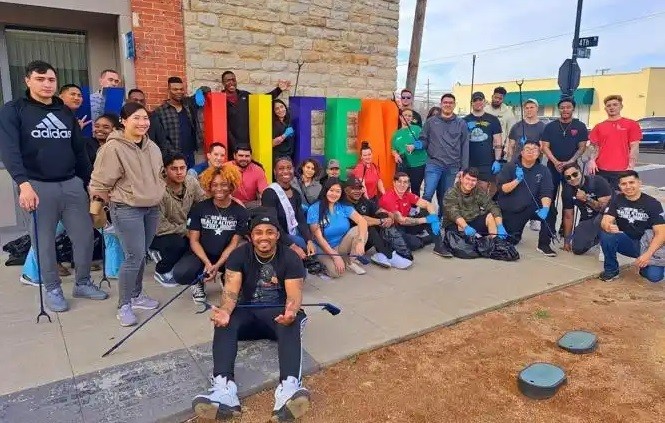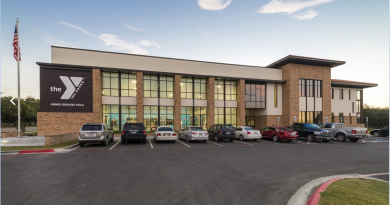Bloomin’ in Bell: Killeen
Revitalizing downtown, local neighborhoods and economic development
By JANNA ZEPP | Photos by BECKY STINEHOUR and courtesy of the U.S. ARMY
Look around Central Texas and you’ll see construction just about everywhere you look. New housing, new subdivisions, new everything explodes all over the area each time you drive the main thoroughfares of Bell County. And in some of our cities, new construction goes up right alongside downtown revitalization.
More than half a decade ago, the City of Killeen spearheaded a move to bring back its historic district downtown in a way that attracts new business and nightlife in a way that city residents can be proud of.
“Killeen is big enough to pursue any dream you can create yet small enough so that you can not get lost in the shuffle. The full potential of this community has yet to be fully discovered, and is the best asset for anyone seeking to stake their own claim.”
— Michael E. Linnemann, Owner/Broker of Linnemann Realty
Contractors and local artists have been working together to rebuild and restore old properties and give the area new life. Many of the businesses downtown made or are making improvements using grant money. Many of the 1920s-era edifices are getting period-appropriate upgrades that reflect each venue’s original architecture with a 21st century amenities.
In the last few years, Killeen has even begun a weekly farmers market downtown, and members of a Fort Cavazos organization, Better Opportunities for Single Soldiers, rolled up their sleeves and got their hands dirty to help revitalize downtown Killeen in January to perform beautification projects throughout the historic downtown area.
Kate Kizito, downtown revitalization director for the city of Killeen, credits the BOSS partnership as an excellent way to get soldiers involved locally and make Killeen a better place for everybody, and mentioning the city’s rich history. It is the first registered mid-century modern historic district in the state of Texas, and the “King” himself, Elvis Presley, was stationed at what was once Fort Hood in the 1950s.
“A lot of our culture is in these walls, our memories are in these walls and to make sure that this area is brought along to the future is important,” Kizito said. “The historic district is just steps away from the Rancier gate and I think it’s so important that soldiers feel at home when they come down here, that they know there’s great restaurants, great places to go on the weekend to hang out, fun places for their families to visit. So, it’s important for us to get the BOSS program down here so that way they feel a part of this community and that we show to Fort Hood that partnership that we all want.”
Soldiers armed with trash pickers and trash bags picked up litter on Avenue D, from Fourth Street down to 10th Street and surrounding blocks.
Only a few soldiers signed up to participate, but nearly 40 showed up to help.

“Killeen is our city too,” Cpl. Jasmine Tcha, Fort Hood BOSS vice president says. “it’s great to give soldiers a break and let them see their city and get out and socialize with other soldiers who want to volunteer. More than half the soldiers that are here today haven’t even seen the downtown Killeen area and that there’s more to do. We want to let them know that we care and the city cares about us as well as soldiers.”
The city council recently started a downtown advisory committee and extended an invitation to the BOSS program “to partner together and ensure downtown Killeen is a place where everyone in our community wants to be,” Kizito said.
Cpl. Kandice Harmon, BOSS unit representative, shares her excitement.
“Volunteering is a big part of a soldier’s life but it’s also a big part of personal life as well. There’s so much to do to give back to the community, and if it’s just offering a little bit of your time out of your day to do something such as beautification and picking up trash, then there’s no reason why we can’t get out of bed, get dressed and get out here and get some work done,” Harmon says.
Downtown beautification extends also to publicly viewable art. From the intersection of Gray Street and Avenue D in downtown Killeen, observers can see three works of public art: the full-color, 40-foot military history mural completed by the Killeen Arts Guild, a Gray Street two-story cowboy who has been repainted a few times over the years as his jeans fade, and a mural pulls out of the alley behind a train engine, the symbol of Killeen’s genesis, by artist and veteran Joe Perez III, who has completed public artworks at several locations across Killeen.
The far west portion of the painting depicts an engine car, complete with cow catcher, steaming past the rail station with downtown Killeen reflected in the windowpanes. Following that momentum in a cloud of locomotive exhaust comes a long line of Killeen’s history, rendered in a style reminiscent of both tattoo work and graffiti-style street art.
“In 1997, I joined the Army and came to Fort Hood (Cavazos). As a young single soldier with no family or friends your military buddies become your family and the community becomes your home. I’m proud to serve the people and our community.”
— Ernesto Servan, Garlyn Shelton Auto Group
Killeen residents also run their own TLC efforts.
Kristin Wright, board of directors chair at Killeen Creators, a local nonprofit plowing fertile ground in a city where many neighborhoods have been deemed a food desert, has a vision of a community garden within walking distance of every citizen in Killeen. According to the U.S. Department of Agriculture, a food desert is an area where many residents both live in poverty and reside more than one mile from the closest large grocery store. And because low-income residents who live across town from stores such as H-E-B have almost no access to public transportation, they often opt for buying food at convenience stores that sell mostly processed foods packaged in cans and cardboard boxes.
Killeen Creators response to the food desert status is already making a difference.

Two community gardens on the city’s north side are under cultivation. Volunteers who don’t mind a little dirt under their fingernails till the ground, pull weeds, shovel dirt, and come home with a basket of onions, tomatoes, carrots or whatever’s in season. Wright says the experience is transformational. Sharing a garden with neighbors and strangers brings people together.
Volunteers who gather at the gardens on Sunday afternoons come from a diverse cross-section of residents. Veteran soldiers with PTSD find gardening especially helpful. And seniors with rheumatoid arthritis somehow manage their walkers and braces and kneel to tend the soil. A 70-year-old man with obsessive-compulsive disorder has taken charge of watering. Twice a day, without fail, he’s on the job, ensuring the gardens don’t dry out. His caretaker says this activity has eased the effects of his disorder. Prison parolees needing to complete community service hours also work in the gardens.
Local business development recently got its own facelift of sorts. The Greater Killeen Chamber of Commerce introduced its new vice president of economic development, Robert Watts, in March. Watts, a key staff member for the Killeen Economic Development Corporation, took over the position following the retirement of Phyllis Gogue who worked for the chamber for more than 26 years, with 22 of them being in economic development.
Watts has over 20 years of economic, business and community development experience, and has worked in executive leadership positions with the Austin, San Marcos and Hillsboro chambers of commerce as well as holding roles with the cities of Temple and Waco.
“It is a privilege to be able to join the greater Killeen chamber team that is doing tremendous work on behalf of the community and its existing and future businesses.” Watts says, “Returning home to this area and being able to enter back into the chamber and economic development industry is something I am very excited to be able to do.”
Watts most recently held the position of director of regional operations for the Austin affiliate of Habitat for Humanity International where he helped developed real estate, construction and funding efforts involving multimillion-dollar projects and programs.
“Not many people are afforded the opportunity to give back to the community in which they were raised and this for me is an extreme honor.” Watts says, “I believe the outlook for the Killeen area is a bright one and I cannot wait to be able to help and serve our community in every way possible to help our leaders build the local economy.”




